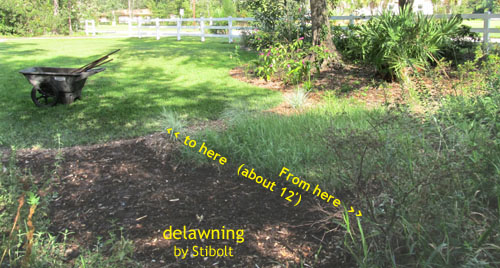 |
| The newest section of lawn to bite the dust will be the unmowed portion next to the front meadow. |
We've been reducing the lawn since my husband and I moved into this house in 2004. In the top photo, the lawn sodded with St. Augustine grass extended almost to the fence. The previous owners had left some mature trees around the edges of this part of the lawn, which we now call the front meadow. We stopped mowing it because the ground was uneven and often had a large puddle in the center after a hard rain. We maintained it as a meadow for a number of years, but now we've stopped cutting it entirely and a nice assortment of oaks, sweet gums, and pines are becoming a forest. Read my post from a few years ago
Reducing the Lawn in Your Landscape for a better perspective on the process and to find out why what we have is a freedom lawn.
 |
The sprinkler head that used to be in the turf
needs an extender to spray over the vegetation. |
We'd left a tongue of lawn next to the front pond and leading out to the front meadow, but recently decided to reduce it even more. My husband stopped mowing the tip of the tongue a couple of weeks ago, as you can see in the top photo.
Also, the turf used to go right to the edge of the pond, but now ferns, rushes, goldenrods edge the pond. This has meant that some adjustments to the irrigation system, which draws its water from the lake out back, were necessary. Sprinkler heads that used to be recessed in the midst of the turf, now need extenders so the spray can reach beyond the taller vegetation. In the second photo, my husband adjusts the sprinkler head's arc--this one is located to the right of the cart in the top photo.
 |
To define the new edge of the front meadow I planted three bunches
of Elliot's love grass (Eragrostis elliottii). |
 |
After the wood chips have been added to define the border
of the lawn and to cover the cart path. The newly-laid
chips have a darker color than the ones laid the day before. |
I started the project by removing the sod along new edge of the lawn creating a gentle curve so that it is easy to mow with one sweep of the mower. I planted three bunches of Elliot's love grass (
Eragrostis elliottii) evenly spaced about thee feet apart to give it plenty of room to expand. What was surprising to me is how clayey the soil is here. Other parts of our landscape are quite sandy. I also left room on the pond side for a cart path that leads out to the woodchip pile. (Read my post
Follow the Yellow Mulch Road.)
 |
| Another 12 feet of lawn removed, but I'm not done with this particular project. I'll remove most of the grass and weeds between the love grass and the meadow's old edge and plant some native meadow wildflowers. |
 |
| A variable dancer damselfly on the native blue curls in the morning. |
We have not used any general pesticides on our lawn and other areas of our property since 2004, so the populations of insects and their predators have been increasing. There seems to be a jump in populations each time we remove more lawn and plant more native plants. We have especially noticed many more butterflies, bees, wasps and other pollinators. And we've also seen more bug predators including bluebirds, mockingbirds, wrens, and the dragonflies & damselflies.
This is a good thing!
 |
| A new USDA hardiness chart has been issued. |
Finally, a new hardiness chart.USDA has finally updated the hardiness zone map. The line between zones 8b and 9a used to run through the center of Clay County, where we live, but now that line, if you follow it northward, is at the Georgia state line.
I wonder how long it will take the seed companies to start using this map instead of the old 1990 version.
Here's a link to the USDA site:
http://planthardiness.ars.usda.gov/PHZMWeb/# I hope you have plenty of pollinators in your yard, too.
Green Gardening Matters,Ginny Stibolt




















